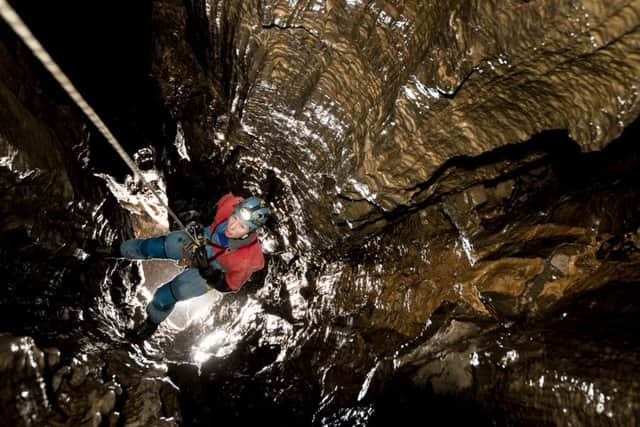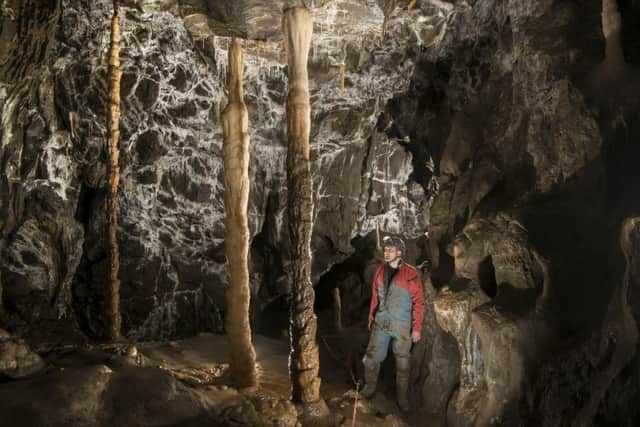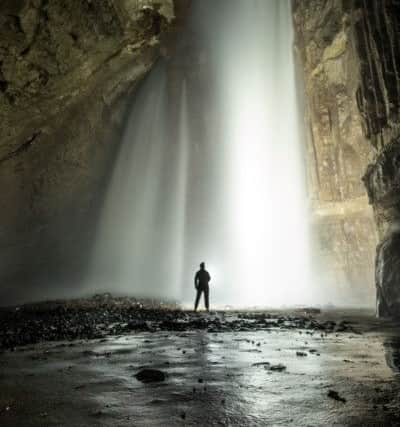Underground map: How red tape threatens Yorkshire's cave network


“We’re doing pretty well at the moment. In fact, we’ve had a pretty busy few weeks,” says David Rowe, who took over the shop a year ago. “The shop was started by Alan and Deanne Steele in the 1970s. They later converted a barn in the village into an indoor climbing wall. I worked there and when Alan said he was selling up I knew it was important that the business survived so I took it on.”
The caving dollar is big in this part of the world and to the economy of the Yorkshire National Park as a whole. Cavers drink in cafes, they go to the pubs and they stay overnight in B&Bs. However, there are fears that unless the Government amends existing Rights of Way legislation, Yorkshire’s underground wonders will be regarded as off-limits to future generations of cavers.
Advertisement
Hide AdAdvertisement
Hide AdTim Allen, who lives a few minutes down the road, is determined to ensure that doesn’t happen. His kitchen table now doubles as the unofficial headquarters for the campaign to open up Britain’s cave network and he has lost count of the emails and letters he has fired off to ministers and conservation groups. The problem began with the introduction of the Countryside and Rights of Way (CRoW) Act 2000. The legislation covers access to land for what it calls “outdoor activities”. Unfortunately, caving is not specified within the Act and as a result some landowners have refused cavers permission to descend systems on their land entirely, while others have imposed onerous restrictions, introducing permits which must be applied for weeks or months in advance.


“See that farmhouse over there,” says Tim, pointing high up on the snow-covered fells above Ingleton. “It’s owned by a lovely guy. He couldn’t be more welcoming, but the daft thing is you could go down a cave opening on his land, walk a few kilometres underground, but if you came out over there during certain times of the year or without a permit you’d be breaking the law.”
Tim, who is leading the British Caving Association’s (BCA) campaign to get the Act extended to include caving, says a number of groups were asked to respond to the original consultation carried out by Defra, but their concerns were ultimately ignored.
“Now there is a great deal of dissatisfaction within the caving community who have understandably been asking: ‘Well, where does that leave us?’ When we challenged Defra they came up with an even more ludicrous definition. They said, it’s OK to go into a cave entrance and it’s OK to explore to the point that daylight runs out. Clearly that point is very subjective, but it also doesn’t make any sense.
Advertisement
Hide AdAdvertisement
Hide Ad“Various legal opinions have been sought and leading QC Dinah Rose concluded that caving is covered by the spirit of the law, which is there really to prevent people descending on some farmer’s barn and saying: ‘Don’t mind us, we are going to have a game of squash.’ That’s fine, but it needs to be made explicit.”


Tim, who was first bitten by the caving bug on a school trip, admits he is a bit of an evangelist when it comes to what lies beneath England’s green and pleasant lands. He is in the middle of a project to photograph the world’s deepest caves, having explored underground caverns as far afield as China and Papua New Guinea, and in 2011 he was part of the team which found the missing piece of the Three Counties system. Widely regarded as caving’s Holy Grail, the discovery linked 70 miles of underground passageways running from Cumbria, through Lancashire and Yorkshire.
“It’s in my blood,” says Tim, whose first date with his future wife was down Gaping Gill, arguably Yorkshire’s most famous cave. “If you want to explore the fells and the moors, you can walk up them, you can run over them or you can bike around them. There is only one way to explore underground and that’s what makes caving unique. There is also something inherently sociable about it. You can’t go without a couple of mates and the experience of being underground is like no other.”
Tim admits that the reluctance of some landowners to encourage caving is down to concerns over their liability if anyone is injured on their land. While he says those worries are understandable, they are unfounded.
Advertisement
Hide AdAdvertisement
Hide Ad“In the past cavers were seen as a bit eccentric, people who got stuck up to their middle and then had to be pulled out by the fire service at great expense and inconvenience. That has changed – of the last 60 callouts to our local Cave Rescue Organisation in Clapham, 52 were fell rescues, just eight were cave rescues and all of those were for minor incidents.


“Twenty years ago you were either a caver, a climber or a mountain biker. Now people tend to do a bit everything, but if you only dip into caving the current situation could well be a deterrent. I know a couple of friends who are big paragliders, but when the weather doesn’t allow them to go up, they like to do a spot of caving. The problem is they don’t want to go on someone’s land without explicit permission, so they don’t go at all.
“I also worry that if you are coming up to Yorkshire and have applied for a permit for a particular cave, then the chances are that even if the conditions aren’t right, you might be tempted to just give it a go.”
The importance of caving to areas like the Dales will be seen this summer when the international conference Euro Speleo comes to Yorkshire. It is organised by the BCA and the European Speleological Federation and its impact is already being felt.
Advertisement
Hide AdAdvertisement
Hide Ad“It’s expected to attract around 1,500 people from all over the world,” says Jon Beavan, owner of the Dalesbridge centre, near Settle, which provides group accommodation for those wanting to explore the area. “I came to Yorkshire more than 20 years because of the caving, so I know how important it is. It’s not just the short-term impact of day trips or weekend stays, but those who come caving will return time and again. They will come back here when they have families of their own and we have to make sure that the countryside is seen as being open to everyone.


“During the foot and mouth crisis we lost 70 per cent of our income and that experience showed just how vital it is to get people into the countryside. It’s something that the Government also says they are keen to do and amending the CRoW Act would be part of that.”
A few weeks ago Tim took a delegation of MPs, including David Davis, the MP for Howden and Haltemprice, into the eight-mile long system at Gaping Gill. He is hoping that they will lobby ministers on the BCA’s behalf, but only time will tell. A few days after meeting, he emails worried that he hasn’t properly conveyed the real attraction of caving. He refers me to a friend, fellow caver Frank Pearson, who is doing a PHD on caving in 18th century literature.
“It is experiencing nature in a way unlike any other,” writes Frank. “It is an intense, altered state of awareness. The beauty of the cave – where rock, and water bring together minerals and earthly elements to sculpt passages and formation of great beauty. And always there is the unknown, the unexplored. At a time when pollution, mass extinctions and global warming threaten the environment, caving is the essential way of grasping and respecting the forces of nature.”
“He says it far better than me,” adds Tim. “But if we are going to get the Act amended we need to make people aware of what beauty lies beneath our feet.”